Measuring the Efficiency of a Room Dehumidifier
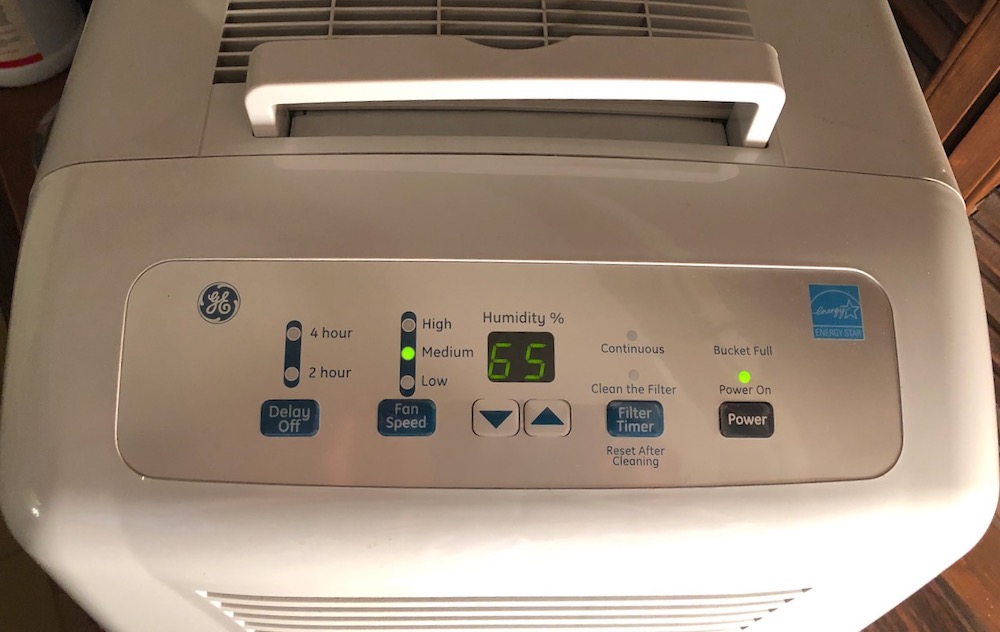
A few months ago, I wrote about the confusing world of dehumidifier capacity. That quantity tells you how much water a dehumidifier will produce in a given amount of time. Here in the US, we use pints per day, but any volume per unit time will work. The efficiency of a room dehumidifier is another important quantity, although it gets far less attention. Dehumidifier efficiency is usually given as the amount of water produced per unit of energy used. And because we’re not completely backwards with regards to units here in the US, we use liters per kilowatt-hour (L/kWh) for that one.
Measuring dehumidifier performance
When you buy a dehumidifier, whether it’s a standalone room dehumidifier or a full-blown whole-house ducted dehumidifier,** you can get the specifications for it. I’ve got a room dehumidifier in my basement that came with the house I bought two years ago. It’s a GE model ADEL50LRL2 made in 2014. The 50 indicates a nominal capacity rating of 50 pints per day.
I looked up the efficiency in a spreadsheet of historical data for older dehumidifiers on the US EPA website. The rated capacity is 51.84 pints per day, and the rated efficiency is 1.85 liters per kilowatt-hour. But how does it really perform? I’m going to talk mostly about the efficiency, but I did take a quick look at the capacity. My data show that it really produces about 38 pints per day, but that’s with the dehumidifier running continuously.
Over a two month period this summer, I collected data on energy use and water produced by this little dehumidifier. I used the same bucket you saw in the photo of my hot water measurements for the volume of water produced. To measure energy, I used an Emporia Smart Plug,* one of my new favorite building science tools. I tracked my data in an Excel spreadsheet.
The official rated efficiency, called energy factor for older dehumidifiers like this one, is 1.85 L/kWh. I actually did measure 1.90 L/kWh one time, but that was an anomaly. I did the experiment in two separate runs. For three weeks, I measured the performance with the dehumidifier running nearly continuously. Then I measured it with the dehumidifier running intermittently. Here are the results.
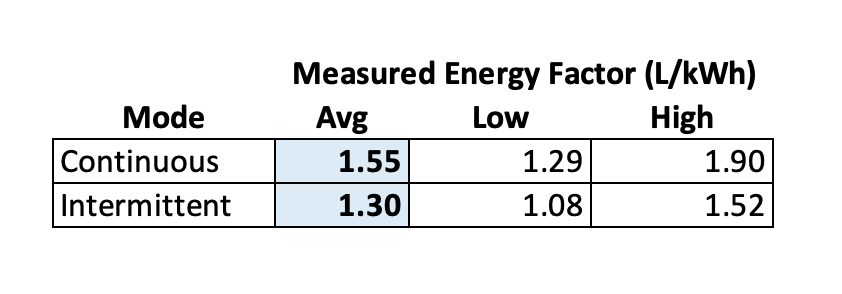
As you can see, the averages are significantly below the rated energy factor of 1.85 L/kWh. When running continuously, it’s 16% lower. When running intermittently it’s 30% lower. The intermittent number is closer to what you’ll probably get in real-world results.
The effect of runtime
Let’s look at three graphs of data from my smart plug.* The first one shows the dehumidifier running continuously. When running, it uses about 485 watts of power. In one hour, it would use just less than 0.5 kilowatt-hour of energy. If it ran continuously all day, it would use close to 12 kWh of energy and cost me about $1.50.
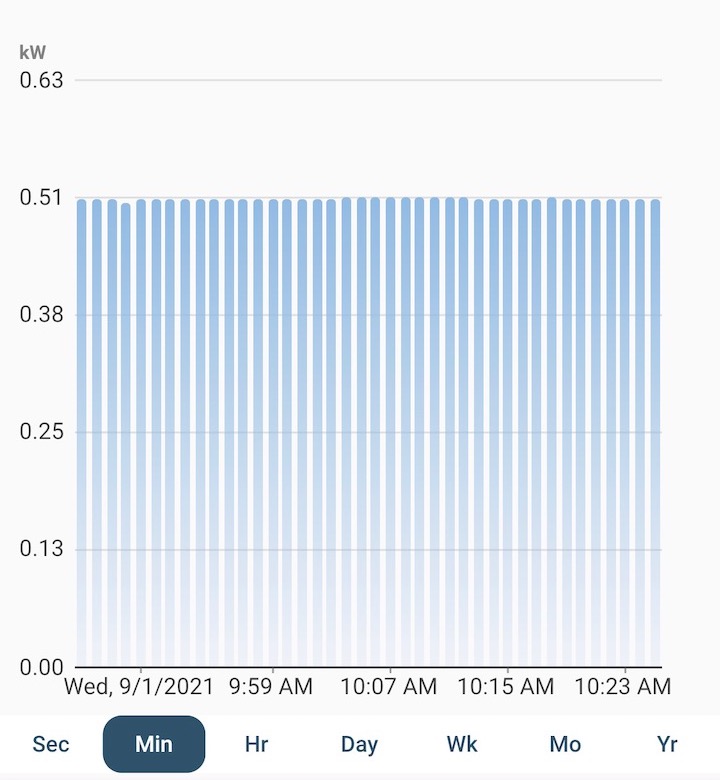
But if you have a room dehumidifier running continuously, you probably ought to look into ways to reduce the humidity through air sealing or crawl space encapsulation. And get a more efficient dehumidifier. In my basement, the dehumidifier cycles on and off when I set it for an appropriate relative humidity. The graph below shows a medium rate of cycling. It comes on for 8 to 10 minutes, then goes off for 4 or 5 minutes.
That hurts efficiency because when the compressor goes off, the coil warms up and loses its ability to dehumidify. When the dehumidifier comes back on, it takes some time before the coil gets to its lowest temperature again.
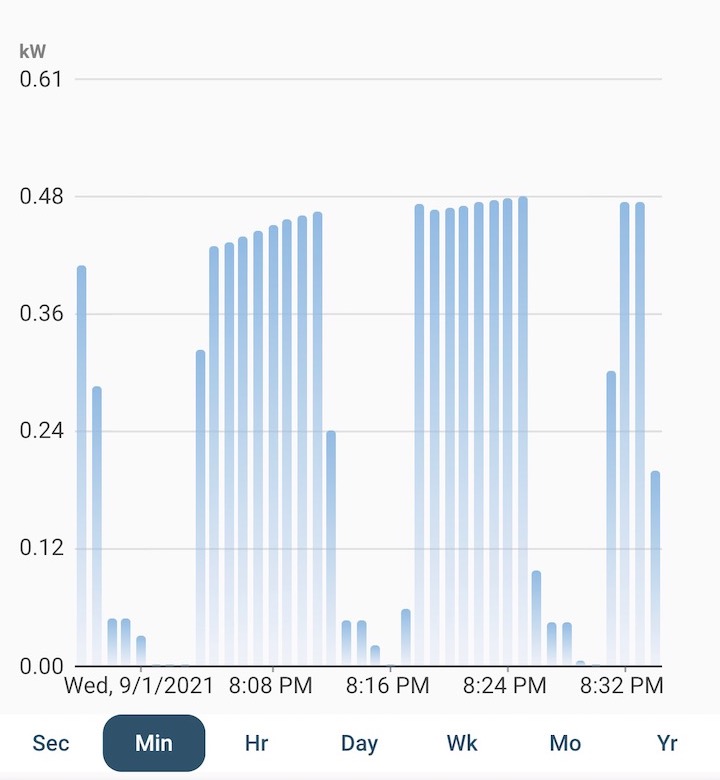
Then there are times when the cycles are short. In the graph below, the dehumidifier gets 2 minutes of runtime at full power with a bit of time ramping up and another bit of time ramping down. Then off for 5 minutes before starting up and having to cool the coil all over again. Not good for the efficiency of a room dehumidifier!
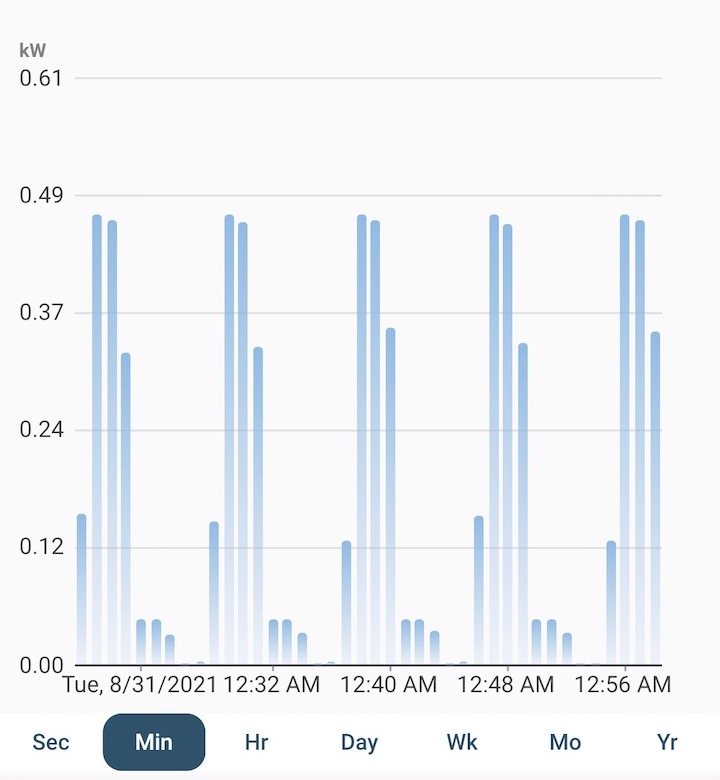
The effect of settings and weather
There are two reasons for short cycling. The first is how you set the dehumidifier. When I first began this little experiment, I set the dehumidifier to 60% relative humidity. That’s when it was running continuously. What was the actual humidity level in the basement? In the low 50s. So I changed the setting to 65% and then 70%. I now leave it at 70% and that keeps my basement relative humidity at about 57%.
The lesson here: Don’t trust the reading on your dehumidifier! They can be very far off. I don’t need to keep the basement at 50% relative humidity. That’s a waste of energy. Plus, I work down there and currently don’t have air conditioning while the basement renovation is on hold until I finish the book. Running the dehumidifier more means lower humidity but higher temperature. (A dehumidifier mostly converts sensible to latent heat. The electricity used also gets converted to sensible heat.)
The second reason for the variation in cycle time is weather. On a hot sunny day, the dehumidifier runs less. I don’t have AC in the basement, but I do get some cool, dry air from the main floor coming down the stairs. When it’s hot outdoors, the AC upstairs runs and dehumidifies more so the basement dehumidifier runs less. At night or on cooler days, the AC runs less, the basement humidity is higher, and the dehumidifier runs more. Those are the best times for a dehumidifier to run, too, because converting that latent heat (humidity) to sensible heat (higher temperature) can make the air conditioner run more.
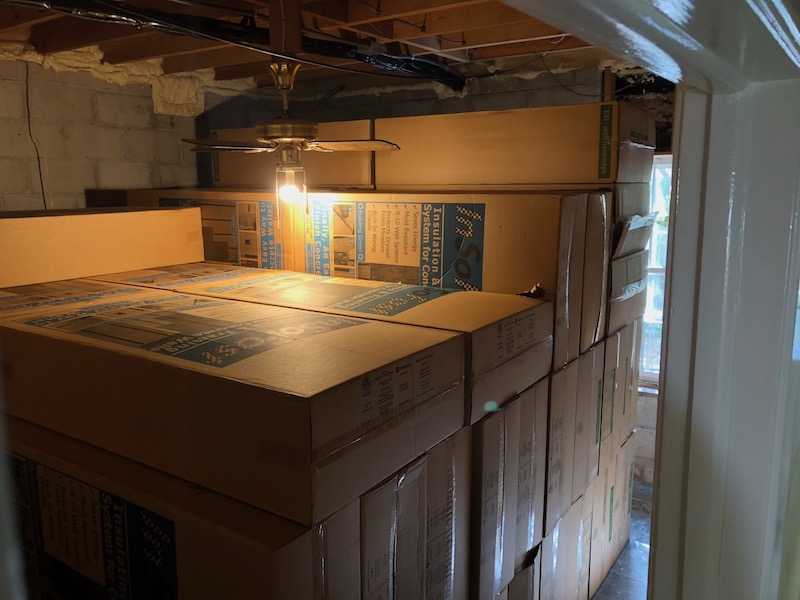
My basement is too humid now for a couple of reasons. I already told you I don’t have air conditioning there. Also, I do have an encapsulated crawl space, but overall the basement is still too leaky. Once my book is done, I’ll gut the whole basement and then install the InSoFast insulation panels (photo above) I’ve already bought, and air seal the heck out of the basement. Because, you know, a house doesn’t need to breathe.
But back to the subject of dehumidifiers. The efficiency of my room dehumidifier is about 1.3 liters of water for each kilowatt-hour of electricity used. How efficient are the best dehumidifiers? The Santa Fe Ultra line of dehumidifiers** are rated at up to 3.6 liters per kilowatt-hour. I’ll be testing one of those in the future.
Allison Bailes of Atlanta, Georgia, is a speaker, writer, building science consultant, and the founder of Energy Vanguard. He has a PhD in physics and writes the Energy Vanguard Blog. He is also writing a book on building science. You can follow him on Twitter at @EnergyVanguard.
Related Articles
The Confusing World of Dehumidifier Capacity
The Perfect Weather for a Dehumidifier
An Energy Recovery Ventilator Is NOT a Dehumidifier
* This is an Amazon Associate link. You pay the same price you would pay normally, but Energy Vanguard may make a small commission if you buy after using the link.
** This is an affiliate link for Sylvane. You pay the same price you would pay normally, but Energy Vanguard may make a small commission if you buy after using the link.
NOTE: Comments are moderated. Your comment will not appear below until approved.
This Post Has 17 Comments
Comments are closed.

I gave my kids a SF Compact. It develope a leak so he grabbed a Room model. He also got a humidistat the plugs into outlet and unit plugs into it. Has digital display. He found he got longer run time and better humidity control. After I fixed the Sante Fe he tried the same with same results.
Bob, long runtimes are the way the get better efficiency and probably longer lifetime, too.
These portables all seem to short-cycle themselves into an early grave because the sensor detects evaporation from the coil and calls for a restart.
I’d rather set them on continuous and use a smart switch or similar to cycle them on-off maybe every 30 mins or so.
RM, thanks for bringing that up. I meant to recommend that at the end of the article, so I’ll go back and add it now. When I first started the experiment, I got continuous runtimes by turning it off for half the day and having the dehumidifier set to 60%, which really tries to hit 50% or lower.
I’d like to just triple down on how big a problem short cycling is with dehu, window AC, and ductless mini. Anything that takes a “room” temp/RH from the a sensor in the unit seems to struggle at a stead state condition if it can idle down low enough.
I’ve a got Hisense Inverter dehu and in “Quiet Mode” it actually runs low enough to hold steady in my basement at about a 130 to 140 watt draw. Once again a variable speed piece of equipment that’s actually matched to the real load range needed is the answer and largely not happening out there.
Love it! Nice write up? I have a follow up thought. Now assuming people already pay the power company to keep indoor space comfortable and dry, how many Liters/kWH does a standard split air-conditioner remove?????
Sometimes for a fraction of the cost of even a “room dehum” you can get a skilled HVAC tech to (for example) pull OUT some freon, install a Pro1IAQ “humidity goal” thermostat and low-voltage control to *slowly* ramp up the air-handler and compressor to get an initial dehumidification impact on each run cycle, make the home cooler and drier and self-dehumidifying. Once your home naturally stays 40% RH May-October you can notice an HVAC problem when humidity creeps up alone, often before the occupant notices their home is not cooling as well. Obviously tight=dry. When a home naturally stays in the 40’s you can “steal” from the home to keep the crawlspace dry and avoid the duhum even though the crawlspace doesn’t have ducts.
More on the Pro1IAQ line of thermostats, they are good for visually impaired people, and they notice “losing ground” so if your home is struggling to stay below 80F it will make the float like .2 degrees F so that you don’t “lose the float” which is something I didn’t even know it could do until it did it. It also notices when the longer float produces better dehumidification and according to your schedule it will over-cool the home and then let it slide several degrees over the set-point to set up another big cycle, trying to time it so the home is over-cooled when you arrive. I would actually love more information if anyone has messed with this line of TStats.
Any suggestions on how to set the fan speed? The GE in the article photo has manual settings low, medium and high. My local electric utility recommends the high setting for better efficiency, but doesn’t provide a reference for that suggestion. I can think of logical reasons to go with any of the options, but don’t have any data. Thoughts?
I’m no expert, and I’m sure one of the helpful brainiacs here will correct me if I’m wrong. But I set mine on low for two reasons. First, it is quieter. Second, and more importantly, I believe it is more efficient for my specific circumstances. My room dehumidifier is placed in front of my home’s central return closet. This means that the air handler pulls air around the dehumidifier whenever the air handler is running, allowing fresh air to enter the dehumidifier. The fan on low expels the newly dehumidified air and mixes it into the room (and into the central return closet). The low fan speed is more efficient because it allows for more condensation to occur on the coils and drip into the bucket rather than being evaporated by higher air speed moving across the coils.
The disadvantage of using the low speed is that it results in less mixing of the dehumidified air. In my situation this is not a concern because the air handler is doing the mixing for me. If you need the expelled air to be mixed with the room air well, then it might be more efficient to run the fan on high.
I would guess that the fan speed would be dependent on the size of the room. Say you wanted to move the dehumidifier around. So you get a dehumidifier that can cover the biggest area. And in that space, you have the fan on “high.” But you take the same dehumidifier and put it in a smaller room, and you might prevent (?) short-cycling by turning the fan down to medium or low, in order to get more run time with less interruptions, so that it can operate more efficiently. I don’t know. Not an expert.
Two follow-up questions:
1. You mentioned “I don’t need to keep the basement at 50% relative humidity.” What, then, was your RH target, especially since the EPA folks say “(RH) should be kept below 60 percent — ideally between 30 percent and 50 percent? (See https://www.epa.gov/mold/mold-course-chapter-2#Chapter2Lesson6, for example).
2. Good point about not trusting the dehumidifier’s setting, but isn’t there another reason for buying a separate, trust-worthy hygrometer? My new SF “advanced 90” (OK, I admit I clicked on your link), senses RH in its immediate area, which is 3-5% drier than other parts of my still leaky but encapsulated crawlspace/basement. Gotta have a separate meter to understand what the whole space needs. Or is that 3-5% difference not worth worrying about?
Looking forward to your book.
Good luck writing!
Another good article. Question: How do you verify that your ambient conditions are at a constant? And if not how do you quantify efficacy if conditions change? By the way, your contractor wanted $20K to replace 2 split systems-no duct work. I guess he priced it per neighborhood landscaping……
Our recent newsletter (see buildequinox.com) has experimental data showing trends in dehumidification efficiency (liters per kWh) and capacity (liters per hour) as humidity changes. Dehumidification efficiency and capacity both increase significantly (2 to 3 times) as humidity increases. The units we tested (Aprilaire E070 and Mitsubishi 1 ton ducted Hyper Heat) both increase in similar manners. We found both units to perform as listed by manufacturer specifications. When dehumidifier and air conditioning units are integrated together, as described in the article, additional efficiency and capacity performance increases can be achieved by dehumidifying outdoor air before it mixes with indoor air.
@Ty Newell wrote:
> Dehumidification efficiency and capacity both increase significantly (2 to 3 times) as humidity increases…. (these) efficiency and capacity performance increases can be achieved by dehumidifying outdoor air before it mixes with indoor air.
Great point. Whenever possible through design, you always want to maximize your deltas. Dedicated outside air systems (DOAS) in commercial buildings follow this approach. For the same reason, thermal storage is used strategically in heating (and cooling) hydronics to maximize the delta-T and thus increase both capacity and efficiency of the source equipment.
I’m partial to the small 22 pint Danby portable dehumidifiers. They are small, quiet and relatively efficient. I particularly like the fact that their discharge air leaves with enough velocity to circulate air in the room – many portables don’t feature that.
I have one in a 800 SF basement room in Massachusetts, another in a small barn in north Florida, and I’m planning another for a garden shed.
It is tempting to oversize dehumidifiers, but don’t succumb – before buying unis in the 40-70+ pint range, do the math to be sure that much capacity is really needed.
@Curt wrote:
> do the math to be sure that much capacity is really needed
How does one do that? Latent loads related to occupancy can be roughly estimated based on ASHRAE guidelines but it seems that latent loads from infiltration are too highly variable and depend more on partial vapor pressure differentials than the infiltration rate itself. And I’ve never even attempted to estimate latent loads from ground moisture, concrete curing, ineffective spot exhaust, etc…
Trial-and-error seems to be the only way to go at this, but if you’ve developed even a rough estimation method through your considerable experience with dehumidifiers, I’m all ears.
Good experiments and good comments, but one factor was left out: the role of federal efficiency standards. By law, the label efficiency ratings must be based on the federal tests for minimum legal efficiency. These tests reflect needs for simplicity (cost of testing), accuracy, and precision. They often are developed from industry consensus standards. If it is easier to get faster test cycle time with good enough accuracy and precision at extreme conditions (high temp and humidity), that’s likely to be the test basis, and moderate temp/humidity field conditions might be lower, systematically. Just like EPA MPG ratings used to be. The environmental advocates like ACEEE and NRDC have worked with the Energy Department and industry to get better rating methods for many products; it’s hard work.
@Harvey, great comment! Reminded me of the age-old problem of how often efficiency ratings are misused to extrapolate annual consumption for ROI or lifecycle cost analyses (mostly an issue with compression based products). Remember those “cooling hour” contour maps? Combine that with A/C capacity and SEER rating, and voila! Instant annual A/C energy consumption! HSPF (for heat pumps) is even worse due to very-difficult-to-model supplemental heat factor.
For the most part, federal efficiency ratings are useful for their intended purpose: product comparisons. But there’s far too much variation in operating conditions for a given home to use these ratings as the basis for energy modeling.